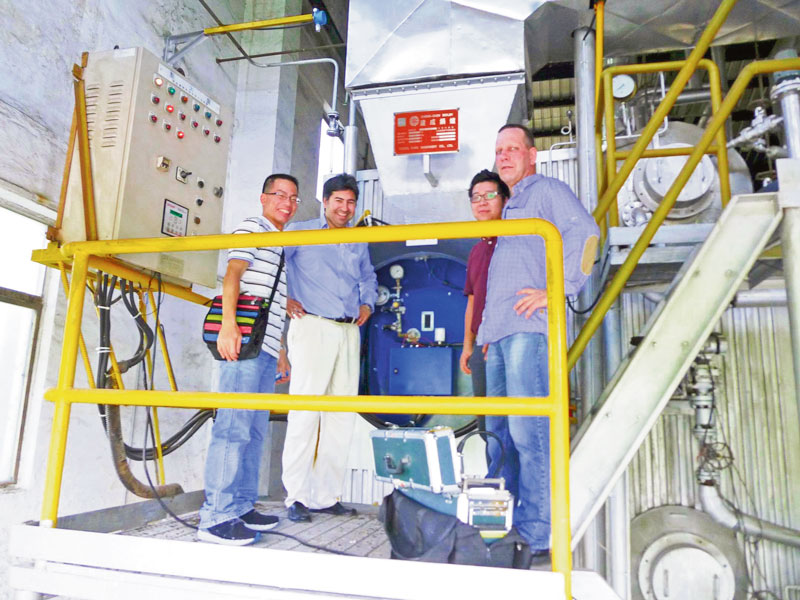
News | Industrial Combustion Equipment
All the latest News on our company
Conversion of coal-fired burners to natural gas
Posted on: 25 / 05 / 2020 | 0 Comentarios | Tags: Conversion of coal-fired burners to natural gas, E&M Combustión, Environmental improvement
Conversion of coal-fired burners to natural gas. After 30 years of rapid growth, during which China’s industrialization and urbanization has continued to progress, the pollutant emissions have exceeded the environment capacity in many areas.

Meanwhile, with increased population demands concerning the environment; towards an increasingly higher number of environmental emergencies, this environmental issue has become one of the major threats to human health, public safety and social stability. Therefore, the significant reduction in the emissions of pollutants is regarded as a fundamental objective for economic and social development, which requires efforts to be made to address the major environmental problems, in areas such as awareness, policy, social competence and institutional arena, in which significant progress has been made .
“When I got the telephone call from Mr. Cai, the Dong Fang Wei Long thermal equipment Company Manager, I was aware the arduousness and urgency of the project. But I didn’t expect that despite it being the world’s most competitive market, and that in the Chinese burner industry, which has over 20 companies that they had to resort to a foreign company for their requirements. Is it because the technical conditions are too stringent?”, states Paul, E&M Combustion China representative office sales manager.
The customer’s facilities are located in the strongest growth area in southern coastal areas of China; it belongs to one of the top 500 companies in the world and one of the first to invest in China. The customer has in this a plant a 30 tonne coal-fired, a 30 tonne oil boiler and several other 10 tonne-15 tonne fuel-oil burners.
China address the environmental improvements and reductions in pollutant emissions
The service life of these boilers is over 20 years old. They produce steam, used primarily in textile dyeing and printing. In line with the country’s decision to control nitrogen oxides emissions in printing and dyeing industry activities, the state-owned gas group decided to join forces with the company on a boilers transformation project, for those boilers which had reached the end of their service life, fuelling their burners with a cleaner energy namely, natural gas. However, the project had the following technical difficulties: first of all, the 30 tonne oil boiler, a combustion chamber diameter of 2.07m and a length of 5.3m. The combustion chamber was obviously too short for a 25MW gas burner flame. Even more serious was that the boiler’s combustion chamber was extremely narrow and that the thermal load exceeded 1 MW/m3. For such a high thermal load, the customer, however, required that the boiler comply with the local government emission requirements, that is, nitrogen oxide emissions <150 mg/m3 of an excess of air lower than 12%
Secondly, the combustion air of the boiler reached a temperature of 80 ºC (in practice, even reaching 100 ºC).
Despite over 20 years of experience in the engineering and distribution of burners, the Guangzhou Dong Fang Wei Long thermal equipment company was also stumped by the very stringent technical requirements of the project. Mr. Cai, the General Manager of Dong Fang Wei Long company, had began to contact several burner manufacturers which many years of engineering experiences and numerous successful programs in China under their belt, but only received one positive response from an Italian burner company, which, however, did not have any offices in China. This was of significant importance, as the issues of the commissioning as well as the maintenance weighed heavily on Mr. Cai. Therefore, Mr. Cai telephoned the E&M Combustión China office with the intention of testing our equipment.
Conversion of coal-fired burners to natural gas
After receiving Mr. Cai’s telephone call, and after a comprehensive review of the project engineering information, Mr. Juergen Praest, the General Manager of the E&M Combustión China office, with vast experience in engineering under his belt, came up with a solution immediately: on the one hand, as regards the 100 ºC combustion air, given that the burner did not have an outer shield, the operators could easily be burned by touching the equipment. To solve this problem, we could adopt the solution applied in the burners of E&M Combustión, with lower costs as well as shorter installation time than the solution offered by its competitors, which consisted of installing a 30 mm thick calcium silicate fibreglass inside the burner and a 1mm sheet of stainless steel as a thermal insulation.

To fit the flame to the smaller combustion chamber size, we have adopted a special combination of primary and secondary air turbulator to the burner which allowed us to accurately control the flame width and length, complying precisely with the customer’s needs in this boiler.
The following point was to control the emission levels at an 88 ºC air temperature which we solved using a lesser amount of primary gas amount to the burner in combination with a internal flue gas recirculation of the flame in the middle of the flame where it is normally done on the outside of the flame. In case of the narrow boiler, there was simply no space for that. With our adjustable gas injectors we could tailor the flame to the combustion chamber size in order to obtain the best results without modifying the boiler.
After only a single burner readjustment, we were able to meet all requirements for this boiler with a very nice looking flame and a NOx level of around 100 mg @ 3% O2 and a CO level below 50mg @ 3% O2.
Both the customer and other burner suppliers who have visited the company have been surprised and inquired how we could do that, given that several of them had rejected manufacturing a burner for this boiler.
In compliance with Chinese laws we had to subject the burner to official testing similar to the German TÜV and it was tested by a state-owned burner testing company from Shanghai. We passed this test without any difficulty.
There is no doubt that this boiler was too short and narrow but at the end of the day it is the end result that counts!


